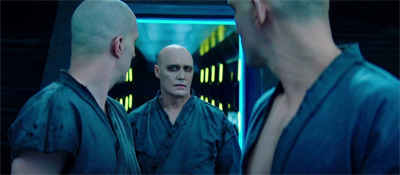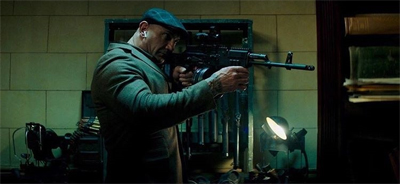Escape Plan was a rather disappointing exercise.
The first Escape Plan had a hell of a hook entirely separate to its central plot. Escape Plan brought together eighties action movie icons Sylvester Stallone and Arnold Schwarzenegger for the first time as equals; not one cameoing in the other’s movie, not a sly wink or a nod, but as leads in an action movie together. This was the b-movie equivalent to Heat, an opportunity to watch two titans square off against one another inside the framework of a vaguely defined science-fiction b-movie. The results were underwhelming, the film feeling too late and self-indulgent.

Escapes and scowls.
Escape Plan 2 is just a bad movie.
Escape Plan 2 seems to assume that the appeal of the original Escape Plan was not in its combination of two iconic action stars collaborating as equals, instead suggesting that the audience for the original Escape Plan was really there for the reheated prison movie clichés that had been handled much better in other movies. And so Escape Plan 2 drops Schwarzenegger for an even more complicated escape from an even more complicated prison. This feels like a fundamental misunderstanding of what the audience wanted. An unsatisfying prison movie without the Stallone/Schwarzenegger team is just an unsatisfying prison movie.

It’s all going according to plan.
The problems with Escape Plan 2 run deeper than the loss of Arnold Schwarzenegger. However, they are a good place to start. Schwarzenegger’s character is never even mentioned in the script, as if to completely erase him from the franchise. In Escape Plan 2, when Stallone’s character refers to a “friend of [his]” who is a “big guy”, he is referring to the character played by franchise newcomer David Bautista. The only other returning character from the original Escape Plan is Curtis “50 Cent” Jackson, which invites the audience to wonder what the point of this exercise is.
At the same time, despite losing the overwhelming majority of the cast from Escape Plan, the sequel seems to believe that the audience is invested in the world of the original film of an end of itself. As such, the script assumes a level of unearned emotional investment in trappings like the three rule of a successful breakout, the fact that the prison featured in the sequel is from “the people behind the Tomb”, and even an extended conversation referencing to Abigail, Amy Ryan’s character from the original film.

Bot to the bone.
Escape Plan 2 is anchored in the idea that Escape Plan was beloved for its mythology and its premise, more than the above the line talent. Indeed, Escape Plan 2 repeatedly assumes that the appeal of these films is in watching characters escape from increasingly absurd penal institutions. So Escape Plan 2 invests hard in making its central prison, “Hades”, the most absurd prison imaginable. It is a combination of a variety of dystopian science-fiction tropes, evoking the sorts of prisons featured in movies like Face/Off or Captain America: Civil War.
At one point, the warden of the prison unironically boasts of his institution, “All the drama of the human condition is represented right here, in my zoo.” There is a sense that the script believes this to be the case. Inmates are randomly forced to battle one another, with the winner receiving “sanctuary time.” The inmates are housed in “spokes.” The guards and staff of the prison are primarily robots, for some reason. Except for the staff who work in the kitchen, for some other reason. It is more a collection of science-fiction and action movie tropes than anything that could plausibly exist.

“So, we shared our obligatory scene. See you in the third act?”
Indeed, at one point, characters openly ruminate on the absurdity of the situation in which they have found themselves; forced to participate in almost daily gladiatorial combat and getting assaulted by handsy robotic prison staff. The prison is extra-legal, its very existence a secret. Some of the people in the prison have secrets that the wardens want, but some don’t. So why not just kill them? “Because then the world will know they are dead,” one of the characters explains. “Here, they are just gone.” Okay. So why not just kill them and hide or destroy the bodies?
To be fair, there are some interesting ideas buried amid the absurdities. The prison is consciously designed to avoid routine and rhythm, repeatedly reconfiguring itself as a way to keep its residents off-guard. The physical properties of the prison are shifted every evening, “like a Rubik’s Cube.” It’s a ridiculous concept, in that it feels like something from Saw or Cube. However, it’s also something that works within the confines of a prison break movie. It adds a level of both escalation and complication to a fairly standard escape narrative.

To be fair, they also borrowed the builders from Prometheus.
However, even this potentially interesting conceptual development is undercut in an overcrowded narrative. This potentially fascinating hook gets lost in the shuffle, between the other weird stylistic trappings of the super-prison (seriously, there are robots! and a recycled “sanctuary” set from Alien: Covenant!) and by the weird narrative convolutions that the film has to go through in order to justify the casting of its three leads and their relative prominence in the promotional materials.
To western audiences, Escape Plan 2 has been marketed as a film starring Sylvester Stallone and David Bautista, but the real star is Xiaoming Huang. Huang’s presence seems to be a nod to the growing Chinese audience for action movies, complete with a pseudo-patriotic subplot about cynical American capitalists trying to steal Chinese technology for their own sinister ends. It is Haung who spends most of the film in the prison, concocting the eponymous escape plan and driving the plot. However, Escape Plan 2 has to justify the billing that it gave to Stallone and Bautista.

Hired gun.
Stallone and Bautista were obviously either unwilling or unable to commit to the film’s primary shoot, and so their characters only intersect with the prison narrative in the final third of the film. As a result, the film has to find a way to keep their characters involved in the narrative until that point. This leads to a number of bizarre choices, such as the decision to have Stallone spend roughly the first hour of a ninety-three minute movie holding boring exposition-driven meetings in a nondescript office. Bautista is offered a handful of stock action movie scenes that do little to drive the plot forward.
The movie seems to understand that western audiences, and fans of the original film, probably signed on to Escape Plan 2 expecting a movie in which Sylvester Stallone concocts an escape plan. So the film clumsily tries to keep Stallone present in the primary narrative by looping his voice over the scenes set in the prison featuring Huang. So the audience is treated to Stallone waxing lyrical about “negative skeleton theory” and reminding the audience that “the one gift every prison gives you is time.”

What everybody wants from a Sylvester Stallone movie: office scenes!
Along the way, the movie offers a handful of pro forma soap opera scenes between various tough guy actors, which suffer from the combination of the audience’s lack of emotional investment and the cast’s lack of dramatic ability. There might be actors who are able to infuse boilerplate workplace drama with tension and anxiety, but Sylvester Stallone and Curtis Jackson are not those actors; a scene in which the two debate any residual bad blood between their characters just feels like the movie is desperately stalling for time, running out the clock.
All of this is incredibly underwhelming, particularly given the opportunity that a direct-to-video release should provide a franchise like Escape Plan. Direct-to-video has arguably become a breeding ground for a new generation of action stars and directors, relying on practical effects and traditional stuntwork, along with genuinely ambitious b-movie storytelling. Universal Soldier: Regeneration and Universal Soldier: Day of Reckoning are much better than any other film in the franchise, and two action movie highlights of the past decade. Unfortunately Escape Plan 2 falls well short of that standard.

It all goes according to plan.
The only escape plan worth making is from the movie itself.
Filed under: Non-Review Reviews | Tagged: action movie, curtis jackson, david bautista, Direct-to-video, escape plan, film, Movie, review non-review, sylvester stallone |




















“Escape Plan brought together eighties action movie icons Sylvester Stallone and Arnold Schwarzenegger for the first time as equals; not one cameoing in the other’s movie, not a sly wink or a nod, but as leads in an action movie together. This was the b-movie equivalent to Heat, an opportunity to watch two titans square off against one another inside the framework of a vaguely defined science-fiction b-movie.”
It’s funny, on paper, “Escape Plan” feels like it has absolutely no business being either a Stallone or a Schwarzenegger movie. If you’d given me the script without any clue about the cast, I’d have been like “okay, so Breslin is basically MacGyver and Rottmeyer is basically Nate Ford from Leverage.” Very little in there calls for musclebound action stars. Which made me wonder if they were trying to branch out into different kind of roles.
Yeah, it’s surreal. It’s a movie that has no idea what the audience wants/expects from it, which is strange given that the premise seems perfectly set up to provide just that.